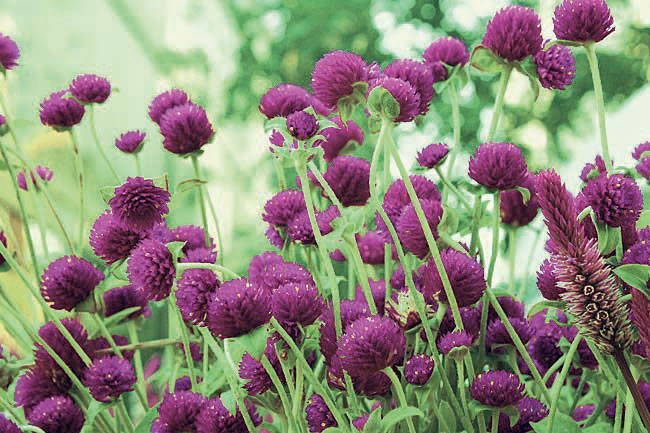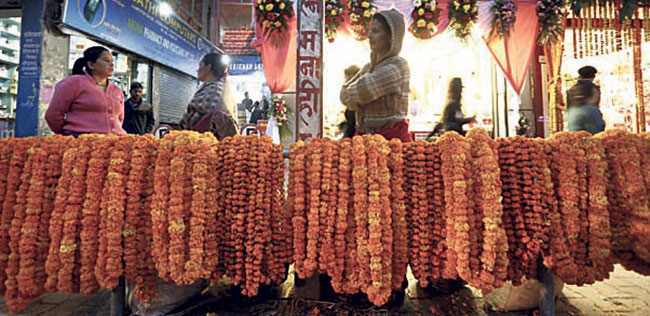Be it marigold blossoms, the hums of deusi-bhailo songs, overwhelming trails of lights or unpredicted burst of firecrackers, they all are indicators that Tihar is just around the corner. Tihar, also called Deepawali’, is a five-day festival celebrated in honor of Yama–the god of death and Lakshmi–the goddess of wealth and domination. A festival of lights, Tihar is mainly about lights, gifts, feasts and firecrackers.
It is believed that decorating the house with lights and keeping it clean will appease goddess Lakshmi, the bearer of wealth, and she will generously bestow riches and wealth to the devotees.
Tihar is considered to be of a great significance as not only the deities and gods are revered but also animals like cows, dogs and crows are worshipped during the five-day festival.
Here are a few most prominent elements of Tihar, without which the grand and mesmeric festival would be incomplete.
Kukur Tihar, the festival of dogs, being celebrated (with photo...

 Flowers
Flowers
As autumn marks the transition from summer to winter, the season provides the best vibes for festivity. The possibilities of summer are gone, and the chill of winter is on the horizon. Skies turn blue, mellow amusing daylight, blossoms of marigolds and globe amaranth, popularly known as Makhmali, are perfect indicators of Tihar. Sales of flower in Kathmandu increases up to 15 percent during the festival as a huge pack can be observed in the streets purchasing garlands of marigold and amaranth flowers. Houses are cleaned and the doorways and windows are decorated with garlands made of saye patri (marigolds) and makhamali (amaranth) flowers. This marks the importance of decorating homes for the cordial welcoming of goddess Lakshmi.
 Decorative
Decorative
Driven by the belief that Goddess Laxmi pays her holy visit to clean houses during Tihar, the festival becomes an annual routine for people to clean and decorate their houses as well as surroundings. Thus, homes are cleaned and decorated by day and illuminated by night with earthen oil lamps. Offering prayers and paying homage to goddess Laxmi, each door step is decorated with footprints made out of vermillion paste, oil lamps and flowers. Oil lamps being commonly used as decorative device are especially used to adorn the porch and balcony of every house. “These days, electric lights are preferred to oil lamps because they are hassle-free and long lasting,” said electric light vendor Bindu Kumari, who has been selling Tihar decorative items since three years.
 Deusi-bhailo
Deusi-bhailo
Deusi and Bhailo are played for two consecutive nights of Laxmi Puja and Govardhan Puja. As dusk falls, people can be seen in the streets and alleys walking with musical instruments - like guitar, drum set, keyboard and many more for deusi and bhailo. With time, the traditional form of singing deusi and bhailo has also been modernized. Groups of people, irrespective of their age, caste and culture, visit house to house, sing folk songs and ask for prasad (offerings made to the gods) as they play deusi-bhailo. As said in the chorus of the songs, deusi-bhailo was initiated a part of reverence to the Treta Yuga King Bali, who was sent below the earth by Lord Vishnu and could only emerge to the earth’s surface during the five days of Tihar. Bringing happy tidings, deusi-bhailo is a fun act carried out in neighborhoods to strengthen communal ties.
Lights and oil lamps
Deepawali in Sanskrit literally means ‘a row of lights’. Hindus believe that the glow of lights is the one that steadily shines in the chamber of the heart. Sitting quietly and fixing the mind on this supreme light illuminates the soul. It is an opportunity to cultivate and enjoy eternal bliss. So, numerous candles and festive lanterns are lit up for goddess of Laxmi during Tihar. Glowing houses and luminous streets hold another major significance of the festival. Traditionally, people would use diyo (oil lamps) to light up the house. Candles are lit along the doorways and windows to welcome goddess Laxmi.
Firecrackers
There is a belief that bursting firecrackers is a symbol of prosperity and good health. But with increasing concerns for environment pollution, bursting firecrackers has been limited to being an ugly and loud display of wealth. Although bursting firecrackers only invites noise as well as air pollution and scare birds as well as animals, little kids love firecrackers for their mesmerizing sparks. The charm of firecrackers still prevails even though its sale has been restricted.
Rangoli
Making rangolis is more of a borrowed tradition that has only recently emerged and is eminent mostly among youngsters. Nonetheless, it has become a part of Tihar celebrations. A variety of colors are used to decorate the doorsteps and create patterns in the courtyards. Santosh Mahato, street vendor of colors from Sarlahi, said colors share an intense bonding with many festivals as they make occasions joyful.





































